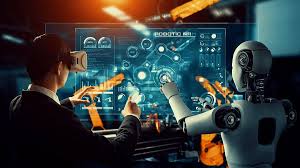Skip to content

Introduction
- Overview of robotics and its impact on various industries.
- The evolution of robots from industrial applications to personal use.
- Why robotics is considered a key technology in the future of work and daily life.
Chapter 1: The Basics of Robotics
- What is Robotics?
- A brief definition and the primary components of a robot (sensors, actuators, control systems).
- The role of robotics in automation and human-robot collaboration.
- Types of Robots
- Industrial robots, service robots, medical robots, and personal robots.
- The difference between autonomous robots and teleoperated robots.
Chapter 2: Robotics in Industry
- Automation in Manufacturing
- How robots are used in assembly lines, packaging, and precision tasks.
- Benefits of robotics in terms of speed, efficiency, and safety.
- Robotics in Agriculture
- The use of robots for planting, harvesting, and monitoring crop health.
- The potential for increased food production and sustainability.
- Logistics and Warehousing
- Autonomous robots for sorting, packaging, and moving goods in warehouses.
- How companies like Amazon are using robotics for efficiency.
Chapter 3: Robotics in Medicine
- Surgical Robots
- The role of robotic surgery in improving precision and reducing recovery times.
- Examples like the da Vinci surgical system and robotic prosthetics.
- Healthcare Robots
- Robots that assist elderly care, rehabilitation, and diagnostics.
- How robots are aiding in providing better patient care and enhancing healthcare systems.
Chapter 4: Personal Robots
- Humanoid Robots
- The development of robots like SoftBank’s Pepper and Hanson Robotics’ Sophia.
- The potential for robots to serve as companions, personal assistants, and customer service agents.
- Robots in Everyday Life
- The use of robots in homes for tasks like cleaning (e.g., Roomba) and security.
- How robots are becoming part of the daily routine for convenience.
Chapter 5: The Future of Robotics
- Artificial Intelligence and Robotics
- How AI enhances robots’ ability to make decisions, learn, and adapt to different environments.
- Examples of AI-driven robots in self-driving cars and drones.
- Ethics of Robotics
- The ethical considerations of robots replacing human jobs.
- The debate over human-robot relationships and the role of robots in society.
- Robotics in Space Exploration
- The role of robots in missions to Mars, lunar exploration, and the search for extraterrestrial life.
- Autonomous rovers and drones used in space exploration.
Chapter 6: Challenges in Robotics
- Technical Challenges
- Overcoming limitations in sensor technology, battery life, and mobility.
- The challenge of creating robots that can operate safely in unpredictable environments.
- Social and Economic Impacts
- Job displacement concerns and how robots could reshape labor markets.
- The social implications of widespread automation in industries.
Conclusion
- The Promise of Robotics
- How robotics has the potential to improve lives and boost economies.
- The need for responsible development and implementation of robotic technology.
- What the Future Holds
- Predictions for the role of robots in daily life, healthcare, education, and more.
- The importance of continuous innovation and adapting to the rapid pace of technological change.

